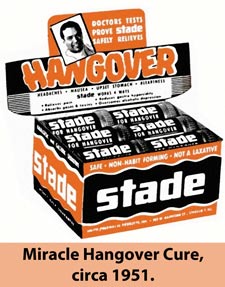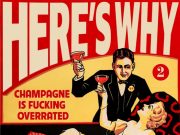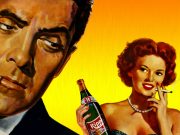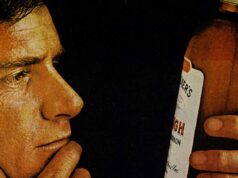It seems a grave betrayal, doesn’t it?
You unpocket a wad of cash to rescue those drinks from a purposeless existence and give them a home. Then, after a bit of hoorahing and carrying you about on their shoulders, the moment you go nighty-night the ingrates turn on you like a pack of teenage werewolves. You awake from a troubled sleep to find the little bastards have successfully conspired to roll you into Hell.
“Who hath woe? Who hath sorrow?” the Old Testament wonders, then gamely pounces on its own question: “They that tarry long at the wine.”
In other words, us.
That woe and sorrow is the boogyman that has bedeviled humankind since we solved the riddle of what to do with all that extra grain and produce left over from the harvest. It has frightened many a strong man from the booze, however temporarily. It has played a part in the defeat of armies and the collapse of empires. It is the crude exclamation point on wedding receptions and New Year’s celebrations. And for some of us, it is how we start our day.
The main reason the hangover seems so oppressive, why its effects are so mythologized in books and barrooms, is because it stands in such stark contrast to what gave it birth the night before: The noble and kind king sires and surrenders his crown to a sadistic cretin, and overnight Camelot transforms into Mordor.
A Quick Note
Though there have been some brief mutterings about the subject in this magazine, I have long avoided writing at length about the hangover, in much the same way medieval monks refused to speak of the Devil for fear the mere mention of his name might add to his power. Every year I submit to radio interviews, which invariably happen near New Years and St Patty’s, and have generally shrugged off possible “cures,” instead informing listeners that hangovers should be taken in stride as part of the Yin and Yang of the drinking experience. This served to make me appear rather rugged and, to be honest, I couldn’t evoke much sympathy for dilettantes who get drunk enough to whine once or twice a year. My usual advice that they should “suffer in silence” is probably why those stations rarely ask me back. But since the hangover is a large, if unfortunate part of the experience, it’s high time we took it to task.
Pain By Any Other Name
We didn’t always call it a hangover. English speakers once had to resort to the rarefied words crapulence and surfeit, in addition to charming euphemisms such as morning fog, gallon-distemper, bottle ache, blue-devils, jim-jams, cropsick, black dog and my personal favorite, bust-head.
The word hangover waited breathlessly in the wings until around 1900, then sprang out like an aging actor finally finding the role he was born to play. Previously the word had merely meant something leftover, but it didn’t take long for it to come to describe a very specific kind of leftover. It’s the perfect word, if you think about it, it’s one of those words so perfectly suited to its task that one has to wonder: what took it so long?
Causes and Effects
Until relatively recently, a shamefully small amount of scientific endeavor was directed toward isolating the physiological causes of the hangover. Beyond the boozing, of course. Prohibitionists and other misguided moralists considered hangovers God’s wrath, a richly deserved punishment for sinful behavior. The medical community, on the other hand, seemed to think that if they did find a cure, why that would just encourage we dumb monkeys to drink even more, which is entirely true, but that’s beside the point.
It took the arrival of the Industrial Revolution, with its factories and punch clocks, to get the Powers That Be concerned about “the one-day flu,” a strange and terrible affliction that was keeping the workers from their places on the assembly line. They couldn’t keep the proles from drinking, though they certainly tried, so they started funding studies to see if they could perhaps find a cure for this production-draining ailment. It took them time, but the scientific community slowly put together a whole litany of causes, effects and cures.
In the 1920s they figured out that alcohol was a diuretic, shifting the body’s hormonal balance and causing it to think it didn’t need all that water. A-ha! they thought. That explains it. Dehydration! All they needed to do was convince the workers to guzzle a gallon of aqua pura and maybe then they’d get their lazy butts back on the assembly line.
But alas, there’s a bit more to a hangover then dehydration, wouldn’t you say? They kept digging.
In the 1930s it was determined that a build-up of lactic acid, the same chemical that makes you feel sore after a workout, was the culprit. Ah-ha! they thought. Drinkers were exercising too much, what with the glass lifting and the vigorous staggering about. Perhaps if they could be encouraged to do some stretches and warm down before passing out they’d show up for work as chipper as . . . naw, that wasn’t going work.
In the 1940s, the New Jersey Beekeeper Association, who were plainly in the pay of the industrialists, issued a report on the heels of a lengthy study of drunken bees, swearing that the best way to beat a hangover was to, yes, get to work and “be busy as a bee!” The workers of the day undoubtedly recognized this for the shamelessly blatant propaganda it was.
In the 1950s they discovered that if test drinkers (poor devils) were given equal amounts of bourbon and vodka, a third of the bourbon drinkers would report hangovers while only 3% of the vodka drinkers would. Ah-ha! they thought: it’s those evil congeners. Congeners (which may include methyl alcohol, aldehydes, histamine, tannins, iron, lead and cobalt) are what gives a liquor its color, taste, character and aroma; in other words, it’s the stuff that makes a liquor not taste like grain alcohol. Needless to say, they are more abundant in the darker alcohols.
But Lord knows you can get a hangover from white wine and moonshine, so there had to be more.
In the 1970s they discovered that when that organic factory called the liver processed alcohol it also spewed a toxic waste into the bloodstream. A-ha! they thought. It was this acidic toxin, acetaldehyde, that was wreaking all the havoc. Headaches, body pain, that overall feeling of malaise was laid at the feet of this powerful new super-villain.
Then, in the 1980s, a series of studies revealed that, in addition to all the other a-has!, our behavior while drinking also contributed to our sorry state in the morning. These additional modifiers included smoking, loud music, shouting, staying up late, lunging about and various feats of physical strength, like tree-climbing and keg-standing.
The History of Hangovers: A Quick Primer
Biblical Times—After beaching the Ark, Noah gets loaded and wakes up with a hangover so cruel he condemns all of his son Canaan’s descendants to slavery.
500 BC—Ancient Greeks engrave their drinking cups with dedications to the spirit Pausikrepalos, whose main gig was curing hangovers.
1845—Italian Bernardino Branca unleashes Fernet Branca, a mysterious 80-proof miracle liqueur/tonic, forever freeing the world from the hangover’s cruel grip.
1901—Soft drink/tonic Irn-bru is released in Scotland, once again freeing the world from the hangover’s cruel grip.
1926—Fernand Petiot invents the Bloody Mary at Harry’s New York Bar in Paris–once again and for realsies this time– freeing the world from the hangover’s cruel grip.
1935—Babe Ruth hits his 714th home run while hungover, not unlike the previous 713.
1936—Leading interior designer Edward Spangerberger reveals that spending your hangover in “a softly colored room—preferably tinted in ivory, cream or baby blue” will reduce its effects greatly but, whatever you do, “don’t go near a room with wild doodads on the wallpaper.”
1953—Poet Dylan Thomas, incapacitated by a 3-day hangover inflicted by his famous 18-whisky feat, is assassinated by a quack doctor.
1998—While oppressed (or perhaps empowered) by a self-described “raging, skull-rattling hangover,” David Wells pitches a perfect game.
2000—RU-21, a miracle hangover cure reputedly developed by the KGB, is released to the masses, once again and forever freeing the world from the hangover’s cruel grip, etc.
2009—The poignant film The Hangover is released, bringing attention to the devastating disease that afflicts millions the world over.
The Flawed Logic of Prevention
There are very nearly as many hangover preventives as there are remedies, and probably every hangover article ever written includes a snotty bit of advice so infuriatingly patronizing that it never fails to make my hands tremble with throat-squeezing rage: “The best way to prevent a hangover is abstinence.”
Which also happens to be the best prevention for pregnancy, in case you didn’t know. And the best way to prevent falling down? Don’t get up! If you need to go somewhere, just crawl around on your belly like a goddamn snake.
To carry the pregnancy analogy a bit further, preventives pretend to be the condoms of the drinking experience. Except most of these condoms are constructed of burlap and leak like a sieve.
The problem with abstinence and nearly every other preventative measure is they tend to get in the way of having a good time and/or getting drunk. Which are, unless I’m gravely mistaken, the main points of drinking enough to register a hangover in the first place.
Sure, drinking a glass of water between every round will leave you feeling less dehydrated come morning, but who the hell wants to shoot water in a bar? And how the devil are we supposed to be the life of the party when we’re sober enough to remember to guzzle water between cocktails?
You can gorge on a high-protein, high-fat feast so as to slow alcohol absorption and not get so drunk, but what the hell kind of deal is that? We’re not drinking all that booze to stay sober, are we? Are we angling to pump-up our punting statistics or are we trying to score a goddamn touchdown?
Avoiding the darker alcohols like bourbon, red wine and dark rum might lessen the pain and you might also dance better if you wear a tutu instead of trousers.
You ask me, drinking with a rigid set of rules in mind is not drinking at all. It’s like mom telling you you can go trick-or-treating, so long as you wear bright-orange body armor and eat a sprig of broccoli between each piece of candy.
It steals away the magic. Getting drunk is a very nearly sacred experience, a wide-open, full-throttle thing, a grand celebration of life, a wild charge through the night. Booze is high-octane fuel and mixing a lot of water with that fuel, as any race car driver can tell you, is a good way to lose the race.
All that said, taking vitamins and certain herbs prior to drinking, especially B-6 and milk thistle, won’t get in the way of all the fun and, from personal experience, seems to work. Maybe.
Drunkard, Heal Thyself
The main difference between most preventives and the so-called “cures” is you don’t have to worry about the cures getting in the way of the fun because the fun is definitely over.
Right off the bat, however, I’m going to say this: a true hangover cure does not exist. How do I know this? Because if it did the person who invented it would be richer, better known and infinitely more beloved than Bill Gates. There’d be a statue of him in your town square and his name would be spoke of in the same breath as Albert Schweitzer and Jonas Salk.
We don’t have a true cure from a lack of trying. From the moment the first caveman groaned awake after sucking on as much rotten fruit as he could get his filthy paws on, mankind has struggled to tone down if not terminate that inevitable pain that follows all that pleasure.
Ask a veteran drinker or bartender for a hangover cure and he’s liable to give you one. Usually they will preface it with, “I don’t know why or how it works, but, by golly, it works!” Some appear to have a medical basis, however vague. Some appear more interested in relieving guilt through punishment and some seem to rely entirely on magic.
Ancient Greeks engraved their drinking cups with groveling entreaties to the spirit Pausikrepalos, whose main job was delegating and regulating hangovers. Their Roman counterparts preferred to wolf down fried canaries and owl eggs. The Mongolians relied on sheep eyes, the Assyrians swore by ground-up sparrow beaks. Colonial Puritans flogged themselves and bled the hangover out, while Old West cowboys brewed up a pot of Jackrabbit dung tea. Voodoo-inclined Haitians would (and probably still do) jab 13 pins into the cork of the bottle that brought the pain.
And then there’s the hair of the dog. The theory that a hangover is largely withdrawal symptoms is a popular one, especially among those you find slumped on bar stools on Sunday morning. The Bloody Mary is the standby, of course, but over the centuries many alcohol-laced concoctions have been put forth. They’re called eye-openers, pick-me-ups, spine-stiffeners, restoratives and bracers and tend to fall into three categories: high-proof fruit juices; spicy, weird-ingredient punishers and sweet and creamy appeasers. Some confer hope (Fog Lifter, Corpse Reviver, Rejuvenator), others describe the state you’re in (Sufferin’ Bastard, Zombie, Morning After). They certainly ease the pain, but then, alcohol always does.
Modern man, perched as he is upon the centuries of stacked wisdom, takes a much more scientific approach than our superstitious forefathers. All sorts of vitamins, teas and herbs are recommended, as is Pedialyte, Paracetamol, brewers yeast, hot peppers, coffee, ice cream, coconut water, prickly pear cactus extract, showers hot and cold, bananas, tomatoes, pickle juice, greasy foods, raw eggs, drugs (legal or otherwise), saunas, vigorous exercise (including sex) and so on, take your pick.
 Add to these amateur entries a whole slew of medical wonders. Though they seem a recent phenomenon, these “scientifically-proven” (and possibly even “clinically-proven”) remedies have been around since at least the 1850s. Long before RU-21, Sob’r-K, Chaser, The Cure, HydRelief, Zaca, Day2Pill, NoHang, Drinkin’ Mate and so forth, there was Stade, ReJuv, ENO, Bromo-Seltzer, Dr. Jung’s Proven Miracle Healer, plus a dazzling array of body tonics and snake oils.
Add to these amateur entries a whole slew of medical wonders. Though they seem a recent phenomenon, these “scientifically-proven” (and possibly even “clinically-proven”) remedies have been around since at least the 1850s. Long before RU-21, Sob’r-K, Chaser, The Cure, HydRelief, Zaca, Day2Pill, NoHang, Drinkin’ Mate and so forth, there was Stade, ReJuv, ENO, Bromo-Seltzer, Dr. Jung’s Proven Miracle Healer, plus a dazzling array of body tonics and snake oils.
Do any of them actually work? Who the hell knows? What I do know is, if you think they work, then they do work. That’s right. It’s all in your head, you see, along with all those hammers and gongs.
The Two-Headed Beast
Like an impatient King Solomon, the great alcohol writer and novelist Kingsley Amis cleaved the hangover in two in his excellent 1972 boozing guide On Drink. He reckoned that the most part of a hangover was not the physical side of it but the metaphysical, meaning the guilt and regret about drinking and the scandalous behavior and heavy spending that sometimes go along with it.
Newspaperman Hal Boyle called it “the rebellion of the soul,” a temporary form of self-hatred. “The mind harries the body,” Hal noted, “as much as the body harries the mind.”
They’re both right and here’s proof: ever notice how a hangover achieved for free or on the cheap never hurts quite as much one that emptied your bank account? Or that during a week-long spree in Vegas or NOLA you’ll recuperate much more quickly and with much more enthusiasm than you would if you were at home? You bound off to the bar full of pep, when normally you’d be shuffling around the house (or office) like a zombie.
Hangovers are extremely conditional and subjective. A sudden terror or extremely good news will snap you right out of one. They’re like those movie monsters who can hurt you only if you believe they can hurt you. If you feel guilty about what you did last night, the hangover gathers strength, it tightens the vice. If you think you deserve a hangover, then by God, you’re going to get your wish.
A 3-Point Plan to Exorcise Guilt
1.) You didn’t throw all that money in a bonfire, you know. It went to support a vital industry. It helped bartenders, cocktail waitresses, and distillery, brewery, and winery workers pay their rent and feed their kids. They’re probably very nice people, maybe even nicer than you. What a swell fellow you are for helping them out.
2.) So you had a good time. So you got a little wild. As Vladimir Nabokov pointed out, “life is but a brief crack of light between two eternities of darkness” and with that in mind, you should not feel badly about getting in as many kicks as humanly possible during your stay on this rock.
3.) If you’re worried about God’s opinion, I wouldn’t. The Bible speaks well of booze, most of the time anyway. God’s main man Noah was a tremendous drunkard and I’ll bet he got a seat in Heaven. Probably a pretty good one, too.
No, Actually There Is a Cure!
So, do I have my own sure-fire hangover remedy? Of course, I do. I couldn’t call myself a proper drunk if I didn’t. The combination attack I’m about to reveal has, in the past, put to flight the most powerful hangovers I could conjure up. It’s a lot of trouble, so I rarely use it, but if you need to lose a hangover fast and don’t mind some hassle, here’s what you’ll need:
Frank’s Scientifically Magical Never-Fail Hangover Cure
An IV of saline solution
A bottle of 80% pure oxygen
Three, possibly four Bloody Bulls (a Bloody Mary with beef bullion)
Apply all three simultaneously and you’ll feel as well as can be expected, given the circumstances.










